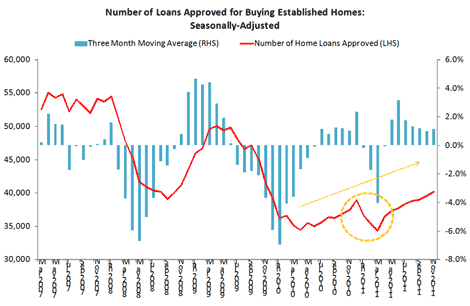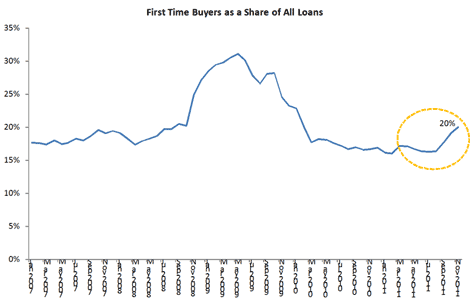Economists' rate cut consensus outcomes await real-world momentum: Christopher Joye

Today I want to give you a snappy summary of my (interlinked) thoughts on both the outlook for Aussie interest rates and our much-maligned, misunderstood yet economically meaningful housing market.
Yesterday’s housing finance data from the ABS confirmed what I’ve been arguing here for months. After the flood-induced downdraft in prices at the start of the year, which was given an equally serious kick-along by the RBA’s de facto double hike in November 2010 (lifting mortgage rates to historically high levels), the number of loans approved to buyers of existing homes has been rising steadily since March.
As I’ve explained before, one wants to focus on the number of seasonally adjusted loans approved for purchasing established dwellings (the red line in the chart below) in preference to the “value” of housing finance series (as this is distorted by house prices) or anything relating to newly built dwellings, which make up a tiny fraction of the established dwellings series.
We are, to be sure, interested in things like finance for construction purposes, which gives us insights into the rate at which new homes are being built. But even the most fervent housing destructionists concede that Australian Building approvals have been running at or below the demand-side, or household formation, implied needs for years now. Coupled with low rental vacancy rates, only a dissembling imbecile would have us believe that Australia’s housing market is characterised by significant excess supply.
Click to enlarge
What we can see from the chart above is that since May 2011 the three-month moving average growth rate for the number of loans approved for purchases of existing dwellings (refer to the blue bars) has been around 1.5%. That means that new home loan approvals have actually been rising at a double-digit pace since March 2011, which is good news for the banks that rely on credit growth to generate profits, and anyone concerned about the quality of the collateral (i.e., home loans) sitting on their balance-sheets (e.g., covered bond investors or hedge funds shorting their stock).
Critically, this demand-side momentum started to materialise well before the RBA bequeathed its interest rate munificence on the market with not one, but two fully passed-through mortgage rate cuts in November and December. They don’t call him Santa Claus Stevens for nothing! And all home owners will be crossing their fingers that Stevens passes out the interest rate presents over and over again, with the financial markets currently pricing in another four to five cuts. If we get that much RBA relief, and the banks pass most of the reductions on, Australia will almost certainly see the return of rapid house price appreciation, much like we did in 2009.
We now know that housing participants responded to the sharp turnaround in home loan affordability almost immediately: in November, RP Data-Rismark reported the first increase in seasonally adjusted dwelling values since December 2010. Observe also in the next chart that one very useful bellwether of the housing market cycle – the share of first-time buyers as a proportion of all loans approved – has surged back to 20%, which is its highest level since February 2010.
Click to enlarge
So all analytical eyes will be focusing on the December house price index results, which are released at the end of this month. Another seasonally adjusted gain in dwelling values will confirm that genuine stabilisation is afoot and excoriate the notion that November was merely statistical noise. I personally expect a surprise on the upside, but only time will tell.
Now to Australia’s central bank. While I will write more on this subject in the days preceding the RBA’s February meeting, it is perhaps most instructive to consider the options available to the bank.
Anyone who tells you that an interest rate cut in February is a “done deal” is a fool. Frankly, nobody knows with certainty, including the RBA, what the outcome of that meeting will be. It hinges most heavily on three pieces of information that we will get over coming weeks:
First, the fourth-quarter inflation data, and any revisions to the second- and third-quarter numbers. This will give the RBA a good feel for the nature of the inflationary pressures bubbling across the economy and whether it was justified cutting rates in November on the basis of one low third-quarter print. The consensus view is that inflation will be very benign in the fourth quarter, which will help the push for a rate cut in February (one economist thinks it will be negative!).
On the other hand, a high print, perhaps combined with some upward revisions to past data, would call into question the RBA’s recent decisions, and significantly reduce the chance the central bank doles out more ‘insurance’ to financial markets. A high quarterly number would be anything clearly in the top half of the RBA’s target 2-3% band (annualised), or, god forbid, beyond.
The second key tranche of data is the December month unemployment results. While the overall tone of Australia’s real economic data has been positive, and, as the RBA has repeatedly observed, insinuates that the economy was tracking at or above trend during 2011 (abstracting away from the floods), there have still been some conflicting signals.
First, there was the very modest step-back in house prices, which look like they will finish the year off around 3% lower. Then there has been some soft retail data based on the narrow monthly surveys, which have been refuted by the ABS’s much more comprehensive consumer spending data contained in the quarterly National Accounts. This tells us that overall consumption spending has been tracking at or above trend over the six months to September.
And finally we have the labour market. While the number of people on the dole has been declining consistently and the number of job seekers receiving unemployment benefits has also been shrinking, the monthly ABS labour force survey has offered a more sketchy story: the closely followed unemployment rate has been bobbing around 5% for the best part of a year, with a marked drop-off in absolute employment growth.
Any spike in the December unemployment data will lend credence to the analysts who have swung around to forecasting a steady increase in Australia’s jobless rate from 5.3% today to over 5.5% during 2012 and, combined with anodyne inflation data, would give the doves on the RBA’s board enough ammunition to lock in another interest rate reduction.
Our final consideration is, as always, the pulse of the global economy, and eurozone conditions specifically. Although Europe itself only contributes a relatively small fraction of global economic growth, which is why the US, India and China have managed to weather its headwinds relatively well, the RBA seems increasingly prone to bowing to pressure from the banks and financial markets to dole out scarce monetary policy insurance to protect these constituents against “tail risks”.
As you can tell, I don’t think this is an especially astute strategy, and would have exercised the “option to wait”, rather than boxing at manufactured shadows. Nevertheless, one curve ball is bank funding costs.
If, hypothetically, the eurozone crisis gets much worse, and the wholesale price of money that banks have to pay – which accounts for about 30% of their total funding – continues to rise (no one seriously disputes that it’s been increasing), the RBA might be convinced that to preserve current lending rates it needs to further lower its target cash rate.
This, crucially, assumes that the banks and their shareholders cannot absorb the higher funding costs themselves via lower net interest margins, lower profits, and lower returns on equity, which, at this stage, remain very high for government-guaranteed utilities.
Fortunately for borrowers, but not savers, none of the above contingencies countenances rate hikes. There is, by definition, some small probability that the next move in interest rates is not actually down.
If you believed the average or “consensus” economist view 12 months ago, you were budgeting on another three to four rate hikes. If you believe the average or “consensus” economist today, you are
banking on another one to two cuts. The truth is nobody knows, and the RBA will be guided by what actually happens in the real world.
Christopher Joye is a leading financial economist and a director of Rismark International and Yellow Brick Road Funds Management. The above article is not investment advice.

